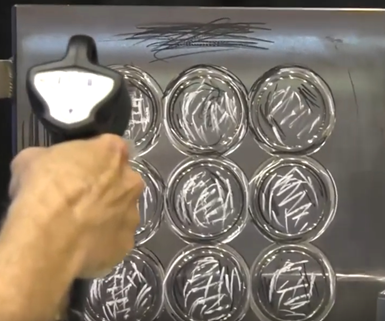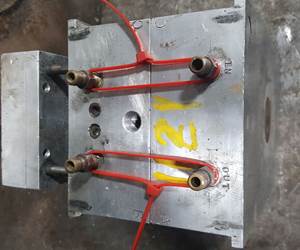Dry Ice Provides Optimum Range of Possibilities in Parts Cleaning Process
Cold Jet LLC showcases how they use dry ice (solid CO2) in their parts cleaning process.
Cold Jet LLC showcases how they use dry ice (solid CO2) in their parts cleaning process. As Steve Wilson, global business unit director at Cold Jet, shows in this demonstration from Amerimold 2019, the company’s technology allows for high specification in the cleaning process, giving parts cleaners the optimum range of possibilities in cleaning their parts and equipment.
Wilson: Cold Jet makes cleaning cool. We take solid CO2, we call it dry ice; that becomes our cleaning media. It's for those who want to clean dry. You want to be non-abrasive and you want no secondary waste. The magic actually begins with the dry ice itself. This is CO2 in its solid phase. It wants to go back and be a gas. You can see the dry ice is sublimating and wants to be a gas. On impact, it will sublimate immediately and go to gas.
This dry ice is put into a machine, like this particular press. We take the liquid, we take the actual dry solid particles, put it into the machine. Then you choose the size particle you want to blast with. This machine allows you to blast with 3 mm if you want. You can stay at the full 3 mm pellet or you can cut it all the way down to a sugar-sized particle: 0.3. We set the pressure. we set the feed rate.
You're going to see three things happen when I clean this tool. There's going to be some kinetic energy. The dry ice is a very soft media. No rockwell number because it's frangible but there is a mohs scale of hardness. It's about a 1.5 on a one to 10 {scale]. One being a towel, a diamond being a 10, your fingernails about a two and a half. So, it's a very soft media. So, I got to accelerate it about 1200 feet a second.
You're going to see some kinetic energy micro-crack that contaminant. It's -109˚F. It's very cold. That cold will embrittle the contaminant. It'll cause the contaminant to shrink. It will lose its bond strength because I froze it. It's coefficient thermal expansion contraction to some materialS. The contaminant is not the same as the P20, or H13 or aluminum mold. The last thing you're going to see is the fact that the dry ice sublimates. It's going to phase from a solid, go back to a gas and in-so doing, will volumetrically grow about 800 times in size. So I’m going to micro-crack it, shrink it and blow up the contaminant.

I'll start with just blowing air. If we blow air only onto this tool, it won't clean it. Air alone will not bring a cleaning solution to this. We bring dry ice into this solution, I will clean it is very complicated places to clean places that you need a Q-tip or pipe cleaner to get down into. So now we're going to get some dry ice into the game. Now you're very quickly and effectively cleaning each cavity out on the processing line while the mold is still in the press. You're cleaning that operating temperature. You're cleaning each cavity one by one, removing what would be off-gases from the different resins. It may be a sacrificial mold release agent. It could be build-up actually—excess polymers on the mold. But little by little, you're cleaning each cavity and what would have taken hours you're now cleaning and minutes. Normally this mold, which is a rubber tool, would have to be cooled, cleaned and then reheated. And we just cleaned it in a matter of seconds.
That's dry ice cleaning. It allows you to clean on-line at operating temperatures to clean tooling whether it's on the process line or back on the tool bench.
Related Content
What You Should Know About Injection Mold Safety Straps
Every mold should have one in order to be safe and OSHA compliant.
Read More5 Hot Runner Tips for Moldmakers and Molders
Best practices for initial hot runner tryouts and effective preventive maintenance.
Read MoreQuestions and Considerations Before Sending Your Mold Out for Service
Communication is essential for proper polishing, hot runner manifold cleaning, mold repair, laser engraving and laser welding services.
Read MoreHow to Use Scientific Maintenance for More Accurate Mold and Part Troubleshooting
Discover how adopting scientific maintenance approaches helps improve mold lifespan, minimize failures, and optimize production outcomes.
Read MoreRead Next
Reasons to Use Fiber Lasers for Mold Cleaning
Fiber lasers offer a simplicity, speed, control and portability, minimizing mold cleaning risks.
Read MoreHow to Use Strategic Planning Tools, Data to Manage the Human Side of Business
Q&A with Marion Wells, MMT EAB member and founder of Human Asset Management.
Read MoreAre You a Moldmaker Considering 3D Printing? Consider the 3D Printing Workshop at NPE2024
Presentations will cover 3D printing for mold tooling, material innovation, product development, bridge production and full-scale, high-volume additive manufacturing.
Read More






















